| | Nutrient management practices and policies | Feeding strategies | Manure collection, storage and treatment | Land application | Zoonotic pathogens | Social issues | Research gaps and next steps | Recommendations for next steps
.
Nutrient Management Practices and Policies
Background
Minimizing nutrient losses and improving the efficiency of nutrient use in agriculture have been major goals of the agricultural industry, governments and various environmental agencies for the last two decades. Across North America, various strategies, including government regulations, economic incentives, industry guidelines, awareness and technology transfer, have been used to encourage the adoption of nutrient management BMPs. Adoption of these BMPs by producers is key to ensuring that their operations are sustainable (Safley, 2003).
Research in the U.S. indicates that improved nutrient management can help to reduce nutrient losses with little negative impact or even a small positive impact on farm profits for some farm types (Camacho, 1991). The same author, Camacho (1991), evaluated the marginal cost per pound of reducing nutrients from different sources (Table 1). He suggested that investing in improved agricultural management practices would be more beneficial for taxpayers than investing in urban infrastructures and practices.
The cost/benefit study showed that it costs three times more to reduce nutrients from urban sources than from agricultural sources.
Table 1. Marginal cost of reducing nutrient losses from different sources
| Source | Cost ($/lb of nutrient |
| Urban best management practices | 142 |
| Public-owned treatment plants | 128 |
| Pasture controls | 10 |
| Farm plans | 45 |
Source: Canado (1991)
The Alberta Government currently uses a combination of regulations, industry-government guidelines, and extension to address manure management at the farm and watershed levels. Examples include:
- manure management standards in Alberta's Agricultural Operation Practices Act;
- funding through the Alberta Environmentally Sustainable Agriculture program for local extension programs, with nutrient management as a major priority;
- the industry-led Environmental Farm Plan program that provides a voluntary, farmer-directed process to assess risks and develop action plans to address concerns, including nutrient management; and
- the Beneficial Management Practices manuals developed jointly by industry and government to provide guidelines for environmentally sound practices, including nutrient management.
Agriculture and Agri-Food Canada (AAFC) provide a number of programs that include technical assistance, research, and some economic incentives for implementing specific BMPs. In Alberta, the BMP programs are delivered by AAFC's Prairie Farm Rehabilitation Administration (PFRA, 2003) and research is conducted by the Research Branch of AAFC. Also, the federal and provincial governments are currently working to finalize the Agriculture Policy Framework. One component of this five-year, federal/provincial cost-shared program includes producer financial incentives to encourage improvements in management practices, including manure/nutrient management practices, to minimize environmental impacts.
In addition, community-based watershed groups, producer organizations and other groups conduct extension programs in Alberta. They are working on nutrient management issues, including, environmental monitoring, field demonstration projects and technology transfer. These groups are able to access technical assistance and/or financial assistance for their projects through a variety of government and non-government stewardship programs.
In Alberta and Canada in general, little money is provided directly to individual producers to help them address environmental issues. In contrast, many U.S. national and state government programs provide economic incentives, such as grants, tax credits, and limiting environmental liability, for producers who implement BMPs related to animal operations.
Solutions
Possible policy/program approaches to improve nutrient management in Alberta include: encouraging nutrient management planning at the farm and watershed levels; providing economic incentives to producers for improving nutrient management; targeting extension efforts to priority areas; and building and strengthening interagency partnerships.
Nutrient management planning (NMP) helps individual producers and watershed groups to identify and implement cost-effective nutrient management strategies suited to their own situation. The NMP approach is based on the cyclical flow of nutrients (Figure 1), and offers a way to deal with the complexities involved in nutrient management. A NMP sets out goals and actions to achieve those goals. A comprehensive whole farm plan addresses site management, feed management, manure handling and storage, land application of manure, land and crop management, and record keeping. The potential benefits of NMP include: improvements in production efficiency; protection of soil, water and air resources; reduction of odours, dust and flies; and improvements in public confidence.
Economic viability is the cornerstone of any successful business operation. Economic incentives have a significant potential to accelerate adoption of nutrient management planning and practices by producers. Some federal and non-government agencies already provide some economic incentives for specific environmentally sound practices. Increasing the economic instruments available to producers for nutrient management practices would help to improve the industry's sustainability while benefiting the environment and society.
Carefully targeting costly effective nutrient management practices could have a large impact on the environment.
Comprehensive Nutrient Management Cycle
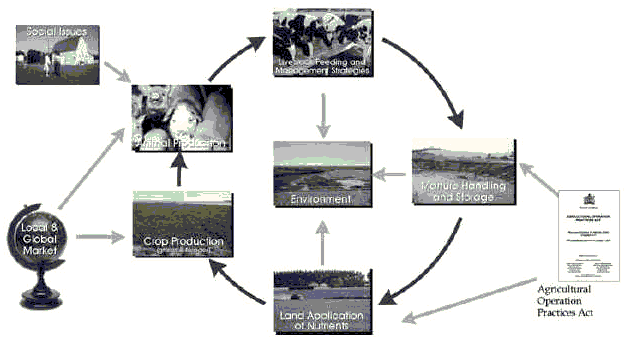
Figure 1. Farm nutrient cycling
Partnerships between government, industry and other agencies are important in identifying and implementing science-based solutions that consider economic, environmental, and social interests and that are based on a thorough understanding of the implications of the various alternatives.
Key research gaps
Research is needed on the following topics:
- Evaluate various methods to encourage producer development and implementation of comprehensive nutrient management plans. This should include evaluation of the costs and benefits those options.
- Determine how to tailor management practices to suit the specific situations on individual farms and individual watersheds so practical tools can be provided to producers.
Feeding Strategies
The following summarizes information from the feeding strategies section and portions of the sections on odour and air quality, ammonia and hydrogen sulfide, and methane and nitrous oxide in the report.
Background
Feeding programs influence the amount of nutrients excreted in the manure and the emission of gases from the animal and the manure. The excreted nutrients of most environmental concern for soil and water are nitrogen and phosphorus. The gases of most concern are ammonia and nitrous oxide (both forms of nitrogen), methane and hydrogen sulfide. Ammonia and hydrogen sulfide are associated with odour concerns, and nitrous oxide and methane are greenhouse gases.
The unused excess nutrients and indigestible nutrients in an animal's ration are excreted in the animal's manure. Thus, formulating rations to accurately meet an animal's specific nutrient requirements could potentially reduce nutrient excretion. However, matching animal needs to feed inputs is difficult because the nutrient content of a feedstuff can vary considerably and an animal's nutrient requirements vary depending on its growth phase, gender and genetic potential. Additional variation occurs at the ration mixing stage and through feed sorting by animals. Therefore, nutritionists often add margins of safety to the minimum recommended requirements to prevent the possibility of reduced animal health and productivity due to underfeeding of nutrients.
Nitrogen: Most nitrogen in animal diets is in the form of protein, and proteins are made up of amino acids. Animals require various types of amino acids in different amounts. The amino acid composition of feeds does not precisely match animal requirements. For example, when diets are based on recommended National Research Council's (NRC) nutrient requirements for livestock, pigs and poultry excrete 45 to 75% of the nitrogen fed, and cattle excrete 65 to 75% of the nitrogen fed. There may be room to reduce these nitrogen losses through diet manipulation.
An "ideal protein" would supply all amino acids in exactly the ratios needed by the animal's body. If an ideal protein is fed to an animal, all amino acids are used equally well, and protein and nitrogen excretion are minimized.
Current practice in pig nutrition is to supply dietary protein to cover the animal's need for the amino acid lysine, which is usually the limiting factor for protein deposition (Allee et al., 2001; CAST, 2002). This approach means that other amino acids are supplied in excess of the animal's requirement and cannot be fully used. The unused excess is excreted.
Similarly, most poultry diets are formulated to contain an excess of protein to ensure the animal's amino acid requirements are met. The margin of safety used in ruminant diets may increase the amount of nitrogen in the diet by 5 or 10% or more above the minimum requirement.
Phosphorus: A large proportion of phosphorus in animal diets is in a form called phytate. Rumen microorganisms can digest phytate, so it is available to cattle. However, phytate is indigestible to pigs and poultry.
The NRC (1998) recommends that pigs should be fed based on available phosphorus. Feeds vary in phosphorus availability (50% in wheat as compared to 10 to 20% in corn). The indigestible and excess phosphorus is excreted. Poultry diets also contain indigestible and excess phosphorus that is excreted.
Although cattle are better able to digest the phosphorus in their diets, their phosphorus requirements vary, depending on such things as whether they are dairy or beef cattle, and their stage of gestation. Typical feedlot rations, even when they are not supplemented with phosphorus, contain more phosphorus than the feedlot cattle require because the base ration ingredients are high in phosphorus.
Methane: All animals produce methane during digestion, but cattle and other ruminants generate relatively large amounts due to the slow fermentation of feed in the rumen. Thus, methane emissions are an important greenhouse gas issue in ruminant production, but are less of a concern for swine or poultry.
Hydrogen Sulfide: Sulfur in animal diets may come from various sources including the water supply, sulfur-containing amino acids, and small amounts of sulfur in the cereals used in the feed. Sulfur compounds, like hydrogen sulfide, are also generated through microbial breakdown of other compounds in manure. Sulfur is an issue for air quality, namely as it relates to odour.
Solutions
Potential management practices to reduce nutrient levels in manure and reduce emissions of odour, methane, hydrogen sulfide, ammonia and nitrous oxide, include:
- testing feed for nutrient levels;
- more closely matching the feed to the animal's nutritional requirements;
- grouping animals with similar nutrient requirements (e.g. by gender in split-sex feeding or by age in phase feeding) to more easily provide their specific requirements; and
- using feed additives to improve feed efficiency.
Although promising, not all of these strategies are currently cost-effective, and some would require modifications in building design and feeding systems. An assessment of the various feeding options shows that the most effective way to reduce nutrient excretion is to use a combination of strategies.
Ruminants: The best combination of available BMPs include:
- reducing the length of the backgrounding period (cost may be a factor),
- improving the growth rate substantially,
- increasing the use of ionophores (Table 2),
- improving genetics and reproductive technologies,
- probable replacement of urea in ruminant diets with nitrates to increase microbial protein production in the rumen and improve animal productivity, and probable incorporation of malate in diets to reduce methane production. (Further research is needed to determine costeffectiveness of replacing urea and incorporating malate.)
Other possible strategies include feeding to the animal's requirements (Table 3), precision feeding, feed assays, using high quality forages, and feeding feedstuffs with high bio-available phosphorus and nitrogen. These strategies will be applied to a greater or lesser degree.
Nitrogen and phosphorus excretion are unlikely to be greatly reduced. A 3% decrease in nitrogen intake and hence excretion is all that could be expected because most ruminant diets contain a surplus of nitrogen even though no protein supplements are added. However, if forage quality increases then dietary nitrogen content and intake will also probably increase. As well, it is difficult to incorporate most of the proposed strategies into cow-calf systems.
Swine: The most promising strategy to reduce nitrogen and phosphorus excretion by pigs involves three components:
- a reduction of dietary protein content with the addition of free amino acids,
- an increase in dietary energy content, and
- a reduction in non-starch polysaccharide (NSP) content. (NSP can interfere with the digestion of nutrients.)
The second most promising strategy is the addition of phytase to diets. Phytase reduces the need to supplement diets with inorganic phosphorus and thus reduces phosphorus excretion. It also improves the availability of other nutrients and animal performance. Evaluation of this option suggests that a 10% reduction in dietary protein concentration, combined with a 5% improvement of protein retention, feed efficiency and reproductive efficiency, would reduce nitrogen excretion to 93% of 1990 levels. The same strategies would result in about a 25 to 30% decrease in phosphorus excretion.
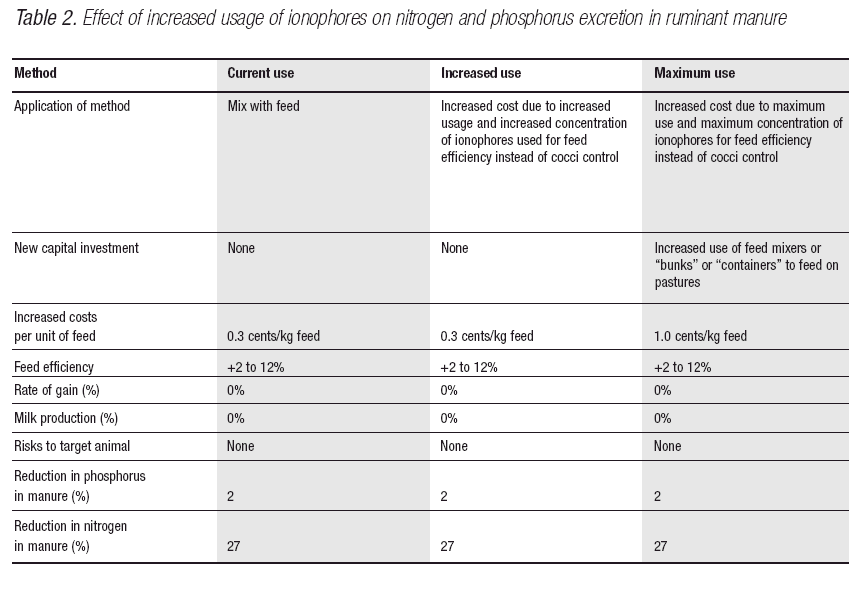
Poultry: Reduction of dietary protein content is the most effective strategy to reduce nitrogen excretion by poultry. It appears that it is possible to implement a 10 to 15% reduction in dietary protein contents immediately. Further reductions, however, require research into amino acid requirements, possibly combined with the concepts of digestible amino acids and ideal protein.
Other means of reducing nitrogen excretion by poultry are less effective, so a combination of strategies will be needed. One possible option is a 10% reduction of dietary protein content, combined with a 5% improvement in feed efficiency and the addition of phytase and NSP-digesting enzymes to poultry diets.
These changes are all within the scope afforded by poultry production and could be adopted immediately. Full adoption of these strategies would reduce the nitrogen excretion by poultry in 2010 to 96% of the 1990 values. However, methane emissions would increase to 106% of the 1990 values.
Key research gaps
The four key identified gaps are:
- Lack of basic understanding of the factors affecting dry matter intake and the relationship of feed intake and feed quality to manure production.
- Lack of detailed knowledge of amino acid and phosphorus requirements of ruminants.
- Lack of knowledge on the effects of genetics and implants on nitrogen and phosphorus excretion.
- Lack of knowledge on the effects of ionophores on nitrogen and phosphorus excretions relative to the effects of ionophores on maintenance energy requirements.
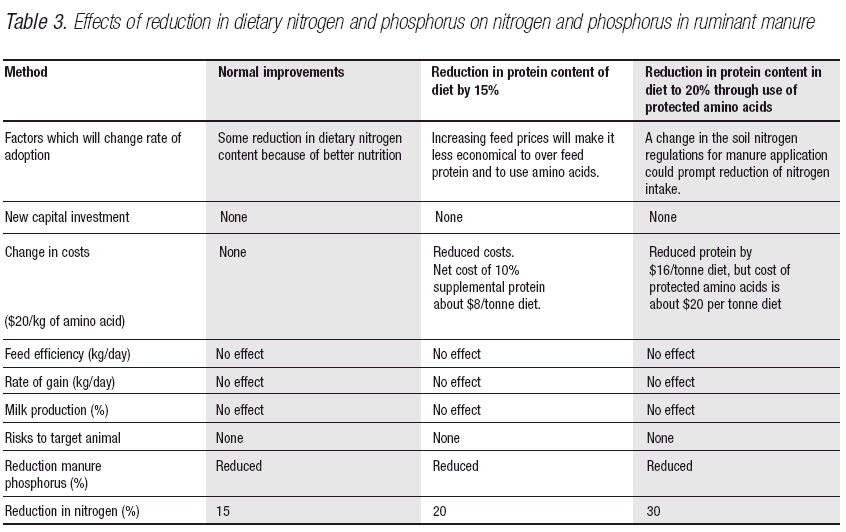
Manure Collection, Storage and Treatment
The following summarizes portions of the sections in the main report about land application and handling of manure, odour and air quality, ammonia and hydrogen sulfide, and methane and nitrous oxide.
Background
Manure handling systems consist of five main components: collection, transfer, storage, treatment, and use (Table 4). Manure composition is variable, depending on animal species, feeds, feed additives, and the manure handling system.Manures typically have a low nutrient content per unit weight or volume compared to commercial inorganic fertilizer. This low nutrient content restricts the distance manures can be economically transported for land application, based on the value of the yield increase they produce relative to transportation and application costs.
Many factors affect a producer's decision on how to handle manure, including capital cost, labour availability and environmental safety. For some livestock types, producers may use solid manure handling systems or liquid systems exclusively, or both, depending on the type of operation and size. It is a challenging task to select between the two systems.
Liquid manure systems are popular in various types of confined feeding operations, especially hog operations, due to the ease of mechanization and low labour requirement. However, liquid manures tend to be more susceptible to emission of odorous gases (e.g. ammonia, hydrogen sulfide) and greenhouse gases (e.g. methane and nitrous oxide), soil compaction during land application, and nutrient leaching after soil incorporation.
Handling manure in solid form has advantages such as lower volume, less runoff potential, and relatively high nutrient retention. On the other hand, solid manure handling systems have such disadvantages as a higher labour requirement, the need for runoff management from storage areas, and the need for impervious pads for storage.
Treatments such as composting can reduce manure volume, increase product uniformity and application ease, and eliminate undesirable constituents such as pathogens and weed seeds. Other technologies, such as bio-digesters (which produce energy and a uniform bio-fertilizer from manure) and various solid-liquid separation systems, show promise in overcoming some of the challenges of dealing with fresh manure while offering value-added opportunities.
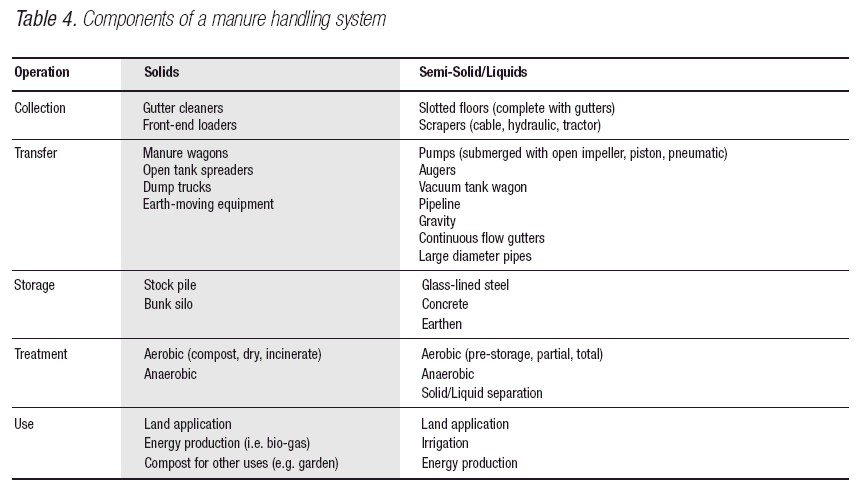
Solutions
Buildings: Conscientious design and management of livestock facilities are critical to minimizing nutrient losses and gaseous emissions. For example, manure collection systems must be designed and maintained to prevent overflow and leakage. Pen surfaces should be kept as clean and dry as practical to reduce odour and dust. In hog barns, slatted pen flooring and adequate floor slope allow proper drainage to help maintain clean, dry conditions. All-in all-out systems allow thorough cleaning and disinfection. Manure collection systems that do not allow the manure to sit and become anaerobic (i.e. low oxygen conditions, which are more odorous) help reduce air emissions.
Ventilation and heating practices can affect air emissions. Improving the ventilation system by increasing airflow rates and by modifying and controlling air distribution can help control airborne dust in a barn. Odorous compounds can attach to dust particles, which may increase persistence of the odour as it disperses away from the source. Lowering the indoor temperature can help reduce emissions of ammonia and hydrogen sulfide.
Biofilters or bioscrubbers can remove ammonia and hydrogen sulfide and reduce odour from air exhausted from livestock facilities. Both technologies rely on the action of microorganisms to breakdown the gases into less odorous compounds. In biofiltration, barn air is passed through a warm, moist, nutrient-rich, porous filter medium before the air is emitted into the outside air (Figure 2). Bioscrubbers use a similar process, but are housed in a closed tower containing water (Figure 3). More research and development is needed to improve these two technologies and make them cost-effective for producers.
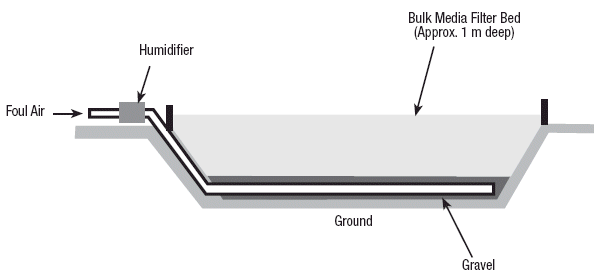
Figure 2. Open soil biofilter
Source: Burgess et al., 2001.
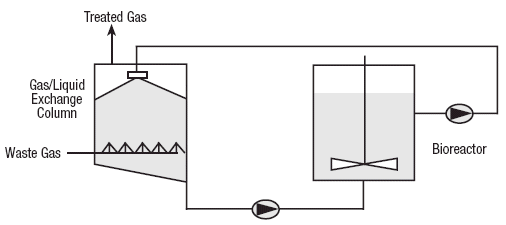
Figure 3. Bioscrubber
Source: Burgess et al., 2001.
Storage: Storage facilities must be designed and maintained to prevent nutrient losses due to overflow and leakage. Practices to reduce odour, ammonia, nitrous oxide, methane and/or hydrogen sulfide emissions from manure storage include the following:
- Covering a lagoon with straw or other biological material reduces odour and emissions of these gases.
- Covering a manure lagoon with a synthetic cover reduces odour, but the covers require an initial investment and continuous management.
- Aerating liquid manure can reduce emissions of methane and hydrogen sulfide, but may lead to increased nitrous oxide emissions.
Treatment: Various manure additives are being developed and marketed as ways to reduce manure odour and other gaseous emissions. However, they are often not researched and tested in the field. Claims about their effectiveness are sometimes exaggerated. As well, those additives that are effective may not be economically feasible for many producers.
Composting and solid-liquid separation can help overcome some of the limitations associated with manure variability and difficulties in achieving uniform application across the field area.
Composting of solids produces humus-like stabilized material that can be stored or spread more uniformly than raw manure, has little odour, and improves soil fertility and tilth. Composting techniques can be as simple as stockpiling and turning, or more complex as in active aeration or in-vessel systems. Proper aeration is the key to achieving good compost, whether through windrow turning or supplying oxygen through a forced air system. Active composting can involve large overhead costs and may be justified only for certain operations. Producing good compost is a blend of art and science, and bad composting can produce as many potential problems with odour and greenhouse gas emissions as fresh manure. Table 5 outlines the advantages and disadvantages of composting.
Solid/liquid separation systems vary in their effectiveness. For odour control and nutrient removal, separators that are capable of removing fine particles, perhaps coupled with chemical treatment, are needed.
Use of the manure solids for energy generation (in the form of bio-gas, composed mainly of methane) is common in Europe. This high temperature anaerobic digestion process is in the development and testing stages in Western Canada. Bio-gas generation produces a uniform fertilizer product, kills pathogens and minimizes odours.
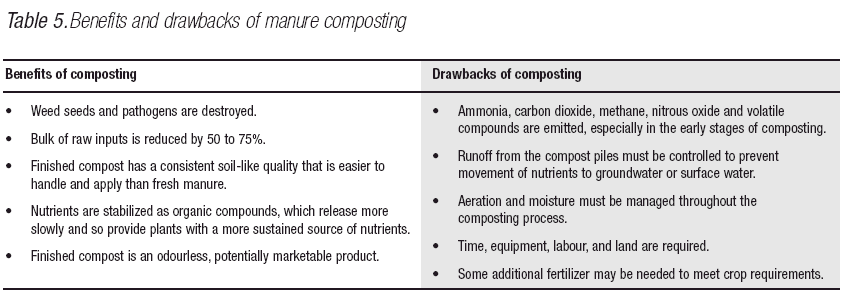
Key research gaps
Research is needed on the following topics:
- Develop widely accepted protocols to measure emission rates of manure gas, odour and viable pathogens from liquid and solid manure and confined buildings and manure application.
- Establish a relevant standard for evaluating manure gas and odour control technology.
- Investigate and determine acceptable odour exposure for humans in terms of frequency, intensity and duration.
- Develop cost-effective, practical technologies to manage manure for energy and value-added products.
- Investigate the basic processes involved in the creation of methane and nitrous oxide from management practices and the interactions among soils, crops/pastures and livestock (i.e. whole farm approach).
Land Application
The following summarizes portions from the sections in the main report about land application and handling of manure, odour and air quality, ammonia and hydrogen sulfide, and methane and nitrous oxide.
Background
Nutrient levels in manure do not precisely match crop nutrient needs. So applying manure to meet the crop’s needs for one nutrient may lead to over- or under-application of other nutrients. Over-application may result in reduced crop yields and nutrient loading of the soil. The excess nutrients are susceptible to loss by runoff, erosion, leaching and gaseous emission. These losses are a waste of the nutrients, and entry of lost nutrients into water bodies and the atmosphere poses an environmental threat. Figure 4 shows an example of the proportion of manure nitrogen that is available to the crop.
Placement of manure, as with inorganic fertilizers, affects the accessibility and use of the nutrients by plants and the likelihood of loss before the plant can use the nutrients. For example, under dry conditions, surface-applied manure nutrients may be isolated from crop roots by remaining in the dry surface layer or, in the case of low density solid manures, they may be redistributed by wind.With heavy rain and high runoff, surface-applied manures are subject to loss by runoff and erosion. Surface applications of manure with a high ammonia and ammonium content are accompanied by inevitable losses of ammonia gas that reduces nitrogen availability to crops and pollutes the air.
Solutions
Options to improve land application of manure include:
- testing manure and soil for nutrient levels;
- applying manure and commercial fertilizers based on crop needs;
- using manure management software (e.g. a system developed by Purdue University to determine application rates);
- injecting or incorporating manure into the soil;
- using composting or other treatment to create a more uniform fertilizer product; and
- applying manure close to the time the crop will need the nutrients (e.g. spring).
Ensuring that the amounts of a nutrient applied to an area over time are in balance with the removal of the nutrient in crop harvest will help prevent over-application of nutrients and nutrient losses to the air and water.When application rates are based on the crop’s nitrogen or phosphorus requirement, the availability of other nutrients should be considered and the manure should be supplemented with commercial fertilizer if necessary.
Researchers are constantly improving software to determine application rates of manure and commercial fertilizer that meet crop nutrient needs without overloading the soil with nutrients. These software programs base rate recommendations on soil and manure test results. They also allow users to keep records for each field on nutrient application rates, soil test values, crop yield and nutrient removal. Such records are useful for longer-term nutrient budgeting. The use of global positioning systems (GPS) and sitespecific soil and yield capability information within a field can further enhance the ability to match manure nutrient applications to crop needs. This can result in more efficient use of applied nutrients.
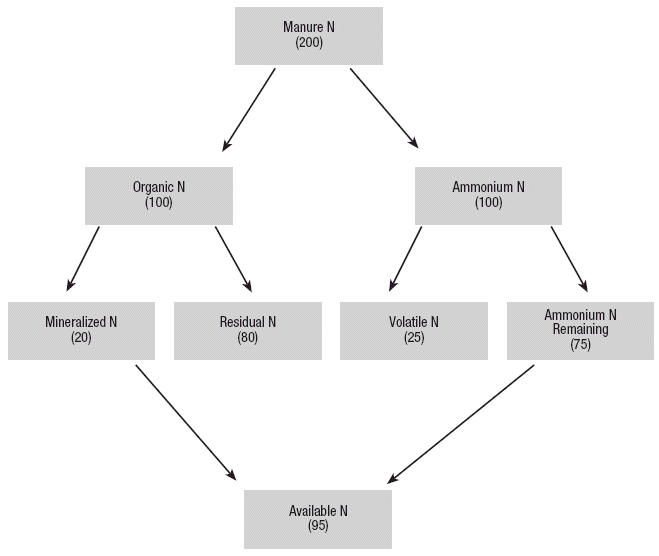
Figure 4. Flow chart showing an approximate contribution of soil-applied manure nitrogen (N) to the nitrogen available to a crop in the year of application. Residual N is that portion of organic N that is not mineralized (decomposed) into plant-available inorganic forms. The numbers in brackets indicate units of N.
Source: After Beauchamp, 1983.
Manure placement in the soil through injection or incorporation increases root access to the manure nutrients and reduces the risk of losses by runoff and volatilization. Table 6 shows the ammonia emissions from various application methods. Injecting liquid manures has been widely adopted on the Canadian prairies. Injection in bands about 3 to 4 inches deep has been reported to improve crop yields and nutrient recovery compared to broadcast and broadcast-incorporation applications for a variety of crops and conditions in Western Canada. Low disturbance applicators are now being used successfully for injecting liquid manures into forage stands and no-till fields.
Key research gaps
Research is needed on the following topics:
- Investigate and document the effects of manure application BMPs on minimizing nutrient losses from agricultural landscapes.
- Evaluate the effectiveness of set-backs and buffer zones on reducing nutrient/pathogen inputs to water bodies in watersheds.
- Develop techniques and strategies to assess the dynamics of manure nutrients, especially nutrient release, in different soil-cropping-climate systems.
- Evaluate options for "mining" nutrients from manured fields using plant and other biological reclamation strategies.
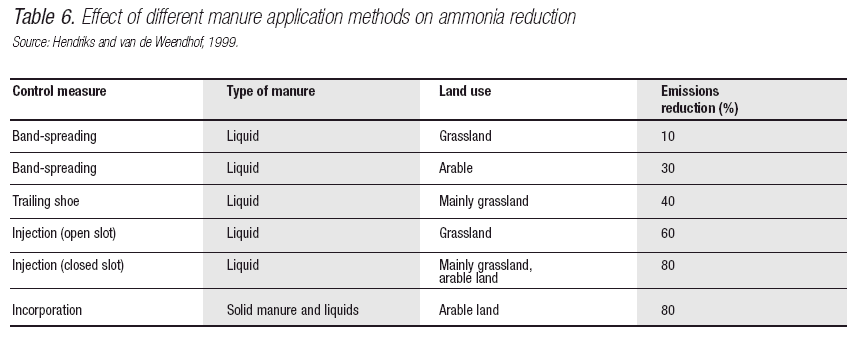
Zoonotic Pathogens
Background
Manure from confined feeding operations and grazing operations is a potential source for pathogens, including bacterial, viral, parasitic or fungal organisms. Zoonotic pathogens are disease-causing microorganisms that can be transmitted from animals to humans. They are more likely to be transmitted indirectly through manure-contaminated food, water or soil. Direct contact (e.g. through wounds or inhalation) is less common.
A limited number of livestock pathogens in manure, water and soil have the potential to infect humans and other domestic animals in Alberta and Canada (Table 7). These bacterial and parasitic pathogens are of concern to the public because they have one or more of the following properties:
- produce severe or fatal disease in humans,
- have a very low infective dose,
- are shed in large numbers in the feces, and
- are relatively resistant to environmental destruction.
Pathogen Survival: Survival of parasitic and bacterial pathogens depends on the manure source, temperature, pH, dry matter content, age and chemical composition of the manure as well as the microbial characteristics. Storing manure as a slurry, solid or compost before it is applied to land, significantly reduces pathogen concentrations. Ultraviolet light and desiccation readily destroy most pathogens. Most pathogens are able to survive freezing or low temperatures for extended periods of time. Some pathogens, such as Cryptosporidium, can survive under a wide range of conditions.
When bacteria adhere to surfaces they become more resistant to antibiotics and biocides. These adherent bacteria are called biofilms. Manure contains biofilms attached to fibre and other inert matter. Biofilms are responsible for chronic infections in humans (e.g. wound infections, medical device associated infections) and animals (e.g. mastitis, implant associated infections). The chemical and thermal treatments used to eliminate manure pathogens have not been evaluated for their effectiveness on biofilms.
Risk Assessment: The level of risk to humans from a pathogen depends on such aspects as: the pathogenicity of the bacteria or parasite (including disease incidence and severity in humans), the pathway of exposure to humans, the infection route, the infectious dose, the prevalence and/or incidence of the pathogen in food and/or water, predisposing health risks and preventative measures. For most of the zoonotic pathogens in Table 7, waterborne and foodborne human infections can be controlled with good food hygiene, proper cooking and water chlorination. Giardia and Cryptosporidium infections are more difficult to prevent because the environmental forms of these organisms are resistant to traditional water treatment like chlorination but water filtration may work.
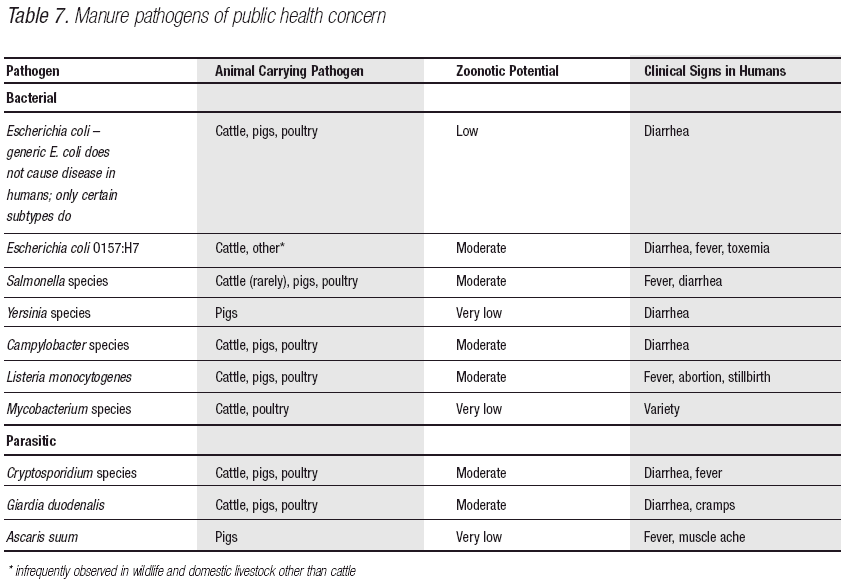
Antimicrobial-Resistant Bacteria: Although the transmission of antibiotic-resistant pathogens from animal manure to humans is a public health concern, there is as yet little information to support or refute this concern.
The gastrointestinal tract of animals is composed of complex microbial communities that may or may not contain zoonotic pathogens. Exposure of bacteria in the gastrointestinal tract to antimicrobial drugs may lead to development of resistance to these drugs.
Antimicrobial resistance may also result through the interaction of resistant bacteria with other types of bacteria. Bacteria are continuously evolving in the environment, and many soil bacteria have multiple antibiotic resistance. Transmission of resistance from environmental organisms to pathogens in manure is potentially feasible. Bacteria have developed several mechanisms of exchanging genetic material that codes for an antimicrobial resistance trait. Antibioticresistant bacteria have been identified in liquid and solid manure from swine and cattle, suggesting that manure may be a reservoir for antibioticresistant genes.
The major public issue is the possibility that antibiotic-resistant bacteria may be transferred from livestock to humans. This transfer may be accomplished through exposure to contaminated water or food products fertilized with manure which are not further processed (e.g. sprouts).
Although studies are limited, with the exception of penicillin, there is little evidence to support that the addition of antibiotics to animal feeds affects the number of pathogens in pigs or poultry. Although the use of antibiotics selects for resistant microorganisms, the microbial ecology is rapidly restored once the antibiotic use is ended. There is some evidence that antibiotic use on the farm can lead to colonization of humans with antimicrobial-resistant pathogens. Antimicrobial-resistant Salmonella in humans has been traced to farms, and contaminated manure is potentially the source of infection. Enterococci that are resistant to the antibiotic vancomycin are emerging as a global threat to public health. Vancomycin-resistant enterococci (VREs) have been isolated from poultry and swine, but not cattle. Transmission of VREs from animals to humans has not been documented.
Solutions
Methods to prevent manure zoonotic pathogens from entering water sources include the following:
- In grazing systems, avoid overstocking pastures, rotate areas used for feeding, grazing and shade, and prevent manure runoff from reaching water bodies by using buffer strips along water bodies, off-stream watering systems, and/or fencing.
- In feedlot systems, properly collect, store and manage manure runoff.
- In cropping systems, apply manure according to the crop’s nutrient requirements and close to the time the crop will use the nutrients, and reduce the risk of manure runoff entering water bodies by using such practices as buffer strips.
- On fruits and vegetables, use composted manure because proper composting kills pathogens. Pathogens are also killed during the anaerobic digester process so the bio-fertilizer produced by this process may also be a good option.
It is also vital to make sure all drinking water is properly treated, to use frequent hand washing, and to use proper food preparation techniques. Proper food handling measures include thorough cleaning of all produce, proper cooking methods, avoiding consumption of raw or undercooked meat or eggs, avoiding consumption of unpasteurized milk, and preventing cross-contamination of foods.
There are many unknowns with respect to the issues around antibiotic-resistant bacteria, so antibiotics should be used prudently in livestock. The Canadian Veterinary Medical Association has developed prudent use guidelines to assist practitioners and livestock producers in reducing the risk of antibiotic resistance.
Key research gaps
Research is needed on the following topics:
- Develop methods for rapid testing of very low levels of Campylobacter, Salmonella, Toxoplasma, Vibrio, E. coli O157:H7, Cyclospora, Cryptosporidium parvum, and viruses in manure, soils, and composts.
- Determine the survival and persistence of manure pathogens in groundwater and surface water in the natural environment.
- Determine the risk of the transmission of resistance from antibiotic-resistant bacteria in manure to other bacteria.
- Determine the level of occurrence of antibioticresistant bacteria in the environment, whether manure applications on land are contributing to the presence of these bacteria in the environment and whether these bacteria pose a health risk for humans and animals.
Social Issues
Background
The social issues related to manure management are strongly tied to the social issues for all aspects of the livestock industry. Of all the challenges facing the livestock industry, social issues such as rural conflict could have the most profound effect on its future competitiveness. Some of the factors driving the need for a greater emphasis on community relations by the livestock industry, include:
- increased attention on the industry by the news media and by activist and consumer movements;
- shifting demographics including a growing proportion of the population with no ties to agriculture and an increasing rural residential population;
- livestock production systems becoming larger and more systematic as a way to become economically viable, but which also leads to greater visibility of the industry; and
- increased competition for resources (land, water and air) due to Alberta’s growing economy and population.
The Edmonton-Lethbridge corridor has a high concentration of livestock operations as well as a rapidly growing population. Some of the most rapid population growth in Alberta is in communities such as Cochrane, Strathmore and Sylvan Lake, where many of the new residents work in nearby major urban centres.
Studies have identified various social issues associated with confined feeding operations and manure management. These include concerns about potential negative effects on human health, food safety, the environment, quality of life, the local economy, infrastructure and animal welfare. Along with such growing concerns, the public also increasingly expects the industry to be open and accountable for its practices.
Although neighbours may prefer that livestock operations move to more remote areas, that option is often not practical and livestock producers may
pre-exist new neighbours. Livestock operations need access to such things as electricity, good roads processing facilities, water, and productive lands. A balance is needed between satisfying the concerns of neighbours and making the most efficient use of resources and infrastructure.
Solutions
The best approach for preventing social issues and conflict is to ensure that sound manure management practices are implemented. This includes following recommended manure management BMPs and regulations. However, even when regulations are adhered to and additional BMPs are implemented, social issues and conflict can arise. Therefore it is also necessary to use BMPs for addressing social concerns.
Beneficial management practices for preventing, reducing or alleviating social issues and conflict generally fall into two categories: public consultation and involvement; and conflict management and resolution. The emphasis should be on preventing conflict through consultation and involvement rather than on managing and resolving conflict after it has occurred.
Alberta’s livestock industry and Alberta Agriculture and Rural Development (ARD) are already taking steps to help producers deal with social issues more effectively. For example, each manual in the Beneficial Management Practices series has a chapter on conflict management. ARD has several publications on conflict management and negotiation, as well as some specialists who work directly with agricultural communities and groups to develop consensus decision-making.
Public involvement is more than informing people. It includes using open, two-way communication and involving them in decisions that may affect their lives. Effective public consultation and involvement builds cooperative working relationships with local communities, interest groups and governments. Public consultation efforts help to prevent conflict before it starts and meet many of the requirements of regulatory bodies such as Alberta’s Natural Resources Conservation Board.
Most public consultation and involvement programs consist of a number of approaches and methods. Table 8 lists some public consultation and involvement methods along with a guide for when to use the methods based on the size of operation. External consultation with municipalities, producer associations, conservation groups and provincial agencies is recommended for some of these methods. Some methods are also best undertaken by a partnership of the appropriate existing industry associations, government agencies, and non-profit organizations.
Key research gaps
Research is needed on the following topics:
- Identify producer interests, needs and concerns regarding reluctance to modify their way of doing business and their attitudes.
- Identify reasons and resolutions for farmer-to-farmer conflict.
- Determine existing policies that are barriers to changing attitudes and ways of doing business.
Research Gaps and Next Steps
Priority gaps
The project team worked through a process to identify the top eight ‘critical few’ gaps. The appendix provides details on the results of each step of this process. During the prioritizing process, the team determined that addressing these gaps was part of developing an overall solution to the two major concerns in manure management: protecting human health and protecting the environment. As a result, the team also developed an overall statement of intent as the foundation for addressing the two major concerns and the individual gaps.
Table 8. Guide for public consultation and involvement.
| Method | Size | External
Consultation | Partnership |
Small | Medium | Large |
| Advisory Committees |  | X | * | * | * |
| Arranged Visits to Comparable Operations | | * | * | * | * |
| Audio-Visual Presentations | | | * | * | * |
| Audit and Certification Programs | | | * | * | * |
| Communication Organizations | | | * | * | * |
| Computer-Based Techniques | | * | * | | * |
| Direct Mailing | * | * | * | * | * |
| Discussions with Stakeholders | * | * | * | | * |
| Displays | | * | * | * | * |
| Hiring Locally | | * | * | | * |
| Honoraria | | * | * | | * |
| Information Bulletins, Brochures, and Fact Sheets | | * | * | * | * |
| Information Centres | | * | * | * | * |
| Links with the Community | * | * | * | * | * |
| Media Briefings, News Releases, and Press Conferences | | * | * | * | * |
| Newsletters | | * | * | | * |
| Open Houses | | * | * | | * |
| Public Hearings | | * | * | * | * |
| Public Opinion Polls | | | * | * | * |
| Seminar and Workshops | | | * | * | * |
| Site Visits and Tours | * | * | * | | * |
| Surveys | | | * | * | * |
| Telephone Hotlines | | | * | | * |
Overall statement of intent
Develop a comprehensive approach for predicting risk through geomatics and GIS to ensure sustainability and enable optimal site selection to reduce environmental and human health risk.
Top eight gaps
These gaps are not listed in any specific order.
- Develop widely accepted protocols to measure emission rates of manure gas, odour and viable pathogens from liquid and solid manure, confined livestock buildings and manure application.
- Determine the survival and persistence of manure pathogens in groundwater, surface water and air in the natural environment.
- Establish a relevant standard for evaluating manure gas and odour control technology.
- Develop a basic understanding of the factors affecting dry matter intake, amino acids and phosphorus requirements of ruminants, and the relationship of feed intake and quality to manure production, nutrient levels in manure and odour/gas production.
- Assess the health effects and impact of ammonia and hydrogen sulfide on workers and residents living near confined feeding operations.
- Develop effective decontamination protocols/products for removal of manure pathogens from agricultural operations and food processing facilities.
- Develop methods for rapid testing of very low levels of Campylobacter, Salmonella, Toxoplasma, Vibrio, E. coli O157:H7, Cyclospora, Cryptosporidium parvum, and viruses in manure, soils, and composts.
- Investigate the effects of BMPs on minimizing nutrient and greenhouse gas releases and losses from animals, livestock buildings, and manure storage, handling and application.
Recommendations for Next Steps
Proposed model for managing similar projects
The team developed a project management process for use by teams working on similar broad and complex topics, including: having a dedicated project manager/facilitator to manage the project; having a team development meeting; and ensuring that the team and the funding agency mutually agree to a detailed outline of what will be addressed in the project, at an early stage of the project.
Proposed process to identify and address priority gaps
The team recommends the following process for identifying and addressing research gaps in the future:
- Develop a collaborative strategy for a focused, comprehensive process to identify and prioritize information gaps relevant to manure management in Alberta. This strategy would include the following components:
- Further investigate current manure management research to determine what research exists or is currently being conducted that is applicable to Alberta conditions and needs.
- Determine all stakeholders’ needs with respect to manure management.
- Develop a process to identify which of the identified gaps have the highest priority.
- Develop a strategy to build and enhance relationships with other provinces to jointly address priority gaps.
- Develop a strategy for collaboration with other agencies at national and international levels to address priority gaps.
Proposed actions to add value to the report
The team recommends the following steps to ensure that the main report will be updated and upgraded, and that the information in the report will be disseminated to interested stakeholders.
- Share the research gaps and prioritizing process with others including researchers, funding agencies, the agricultural industry, and other stakeholders, to ensure that the process and identified gaps are credible from many viewpoints.
- Conduct a critical review process that includes many reviewers to ensure the report is accurate and usable. Ensure that you give these reviewers time to do the review. Negotiate up front with the reviewers about how their review is to be used and with whom it will be shared. Provide reviewers with the final copy of the report along with reasons why some of their input was used or not used.
- Identify missing areas of knowledge, and determine how to address them.
- Package the information in other ways (e.g. fact sheets) to suit the industry’s needs.
- In cooperation with the funding agency, share the final product with other researchers and the industry to obtain feedback for further improvement of future editions of the report.
- Determine who will be responsible for the ongoing process to improve and update the report. Establish a plan and timeline for this process.
- Set up a process to compare the list of gaps in this report with the research underway two years from now, and revise the list of gaps at that time.
- Set up a process to build networks and alliances to tackle the research gaps.
- Consider making the report available as a PDF online. Consider publishing it as a textbook, and look into obtaining a sponsor for publication, production, marketing and distribution of the hard copy.
Adobe Acrobat Reader 4.0 or higher is required to view these files. If you do not have the Acrobat Reader, click on this link to get a free copy:

Executive Summary
Executive Summary - Results of the Literature Review
For a free copy of the Manure Research Findings and Technologies: From Science to Social Issues CD-ROM or hard copy, contact:
Trevor Wallace
Provincial Nutrient Management Specialist
Agri-Environmental Management Branch
6547 Sparrow Drive
Leduc, AB T9E 7C7
Phone: 780-980-7587
Fax: 780-980-4237 |
|